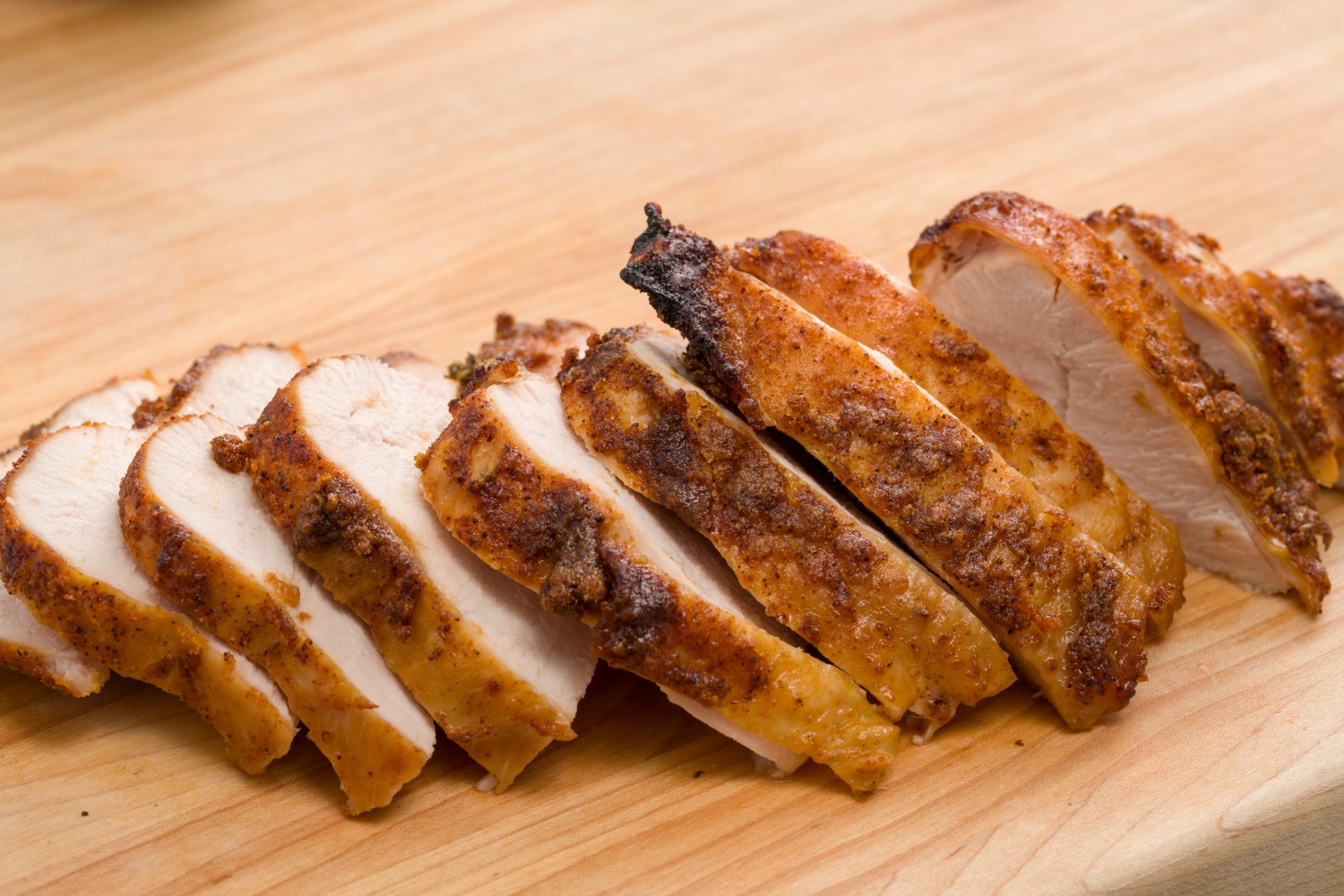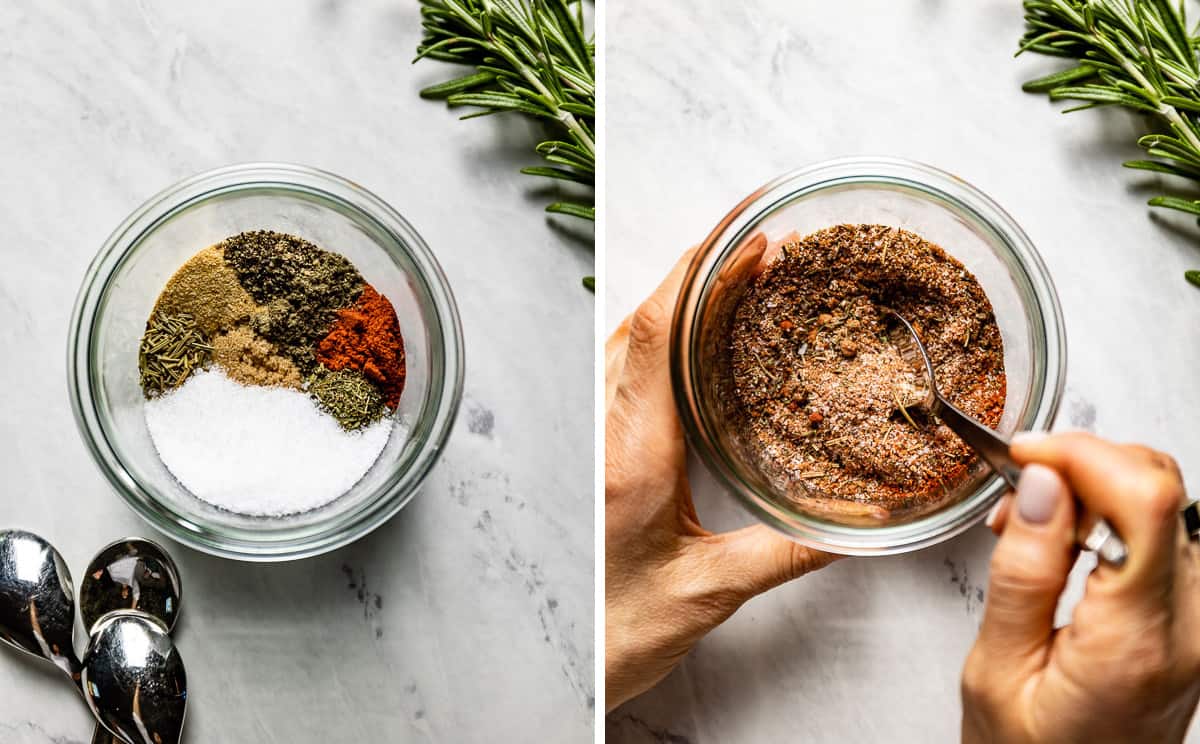Speaking of turkey, we have several turkey recipes here on the blog that you can serve for holiday gatherings or even everyday weeknight dinners. If you don’t want to cook a whole turkey, use this seasoning blend to flavor Baked Turkey Tenderloin, Roasted Turkey Legs, Turkey Breasts, or Air Fryer Turkey Drumsticks.
Any one of these turkey recipes pairs beautifully with my Sweet Potato Casserole and Maple Cranberry Sauce for a crowd-favorite holiday meal that’s sure to impress.
We’re using classic, recognizable spices and herbs for this easy turkey seasoning, so you likely already have all the ingredients in your spice cupboard. This turkey seasoning rub recipe makes enough for 10-12 pounds of turkey, but feel free to adjust or multiply based on your quantity of turkey.
To make the turkey dry rub recipe, gather light brown sugar (or coconut sugar for a refined-sugar free option), paprika (or smoked paprika), dried thyme, dried sage (or oregano), dried rosemary, garlic powder, onion powder, kosher salt, and black pepper.
The beauty of this turkey spice blend is that it’s super easy to customize and very forgiving when it comes to substitutions. So, don’t sweat if you don’t have all the ingredients or if you’d like to make some swaps based on personal preference. Here are some suggestions:
As Thanksgiving approaches, thoughts turn to cooking the perfect turkey. A beautifully browned, juicy and flavorful turkey is the crowning jewel of any Thanksgiving feast. While there are many methods for cooking a great bird, one of the easiest ways to take your turkey from bland and boring to fabulous is to rub it with a homemade blend of herbs, spices and seasonings. A flavorful turkey rub seals in moisture, crisps up the skin and infuses tons of taste right into the meat.
If you’ve never made your own turkey rub before, have no fear! Putting together a homemade blend of seasonings is simple. All you need are common herbs and spices and 5 minutes of time. Once mixed, rub it generously over and under the skin of your turkey. Let it sit overnight in the fridge so the flavors really penetrate the meat. The next day, your bird will roast up incredibly moist, tender and packed with flavor in every bite.
Keep reading to learn exactly how to whip up the perfect turkey rub in your own kitchen. We’ll also cover turkey rub ingredients, how to apply rub to a turkey, and extra flavor ideas and variations so you can customize your blend.
Turkey Rub Ingredients
The great thing about making a homemade turkey rub is that you likely have many of the ingredients on hand already. Here are the main ingredients I recommend including:
-
Salt This brings out flavor in the turkey and helps crisp up the skin Use typical table salt or kosher salt.
-
Paprika: Sweet paprika provides a hint of sweetness, while smoked paprika adds a lovely savory flavor. You can also use spicy paprika for a kick.
-
Onion Powder Dried onion flakes provide tons of flavor without the mess and moisture of fresh onion,
-
Garlic Powder: This adds a punch of garlicky goodness. Use regular garlic powder or roasted garlic powder.
-
Black Pepper: Freshly ground is best for maximum flavor.
-
Dried Thyme: Earthy thyme is a perfect complement to poultry.
-
Dried Rosemary: The piney flavor of rosemary pairs beautifully with turkey.
-
Dried Sage: Sage adds a wonderful woodsy element.
With just these simple ingredients, you’ll have an incredibly flavorful turkey rub ready in 5 minutes flat. Adjust amounts to suit your tastes – add more of your favorite herbs or spices and reduce ones you don’t love as much.
How to Make Turkey Rub
Making your own turkey rub couldn’t be easier. Here’s the quick and simple process:
-
Measure out the desired amount of each ingredient into a small bowl. Use the recipe below or customize to your liking.
-
Thoroughly mix together using a fork or spoon. Make sure everything is well incorporated.
-
Use the rub immediately, or store in an airtight container for later use. It will keep for 2-3 months.
And that’s it – you’ve got homemade turkey rub ready to go! Now let’s talk about how to use it.
Applying Turkey Rub to Your Bird
To get the most flavor and the crispiest skin, it’s important to apply the rub correctly. Follow these steps:
-
Pat the turkey dry, inside and out, with paper towels.
-
Loosen the skin from the breast and thighs gently with your hands. Be careful not to tear it.
-
Rub the spice mix generously over the entire surface of the turkey. Really massage it into the skin.
-
Use your fingers to spread some rub underneath the skin, directly on the meat.
-
Rub the seasoning into the turkey cavity as well.
-
Place the rubbed bird in the fridge, uncovered, for at least 4 hours or up to 24 hours.
-
Roast the turkey as desired – the rub will add amazing flavor!
Letting the seasoned turkey sit overnight allows the salt, herbs and spices to really penetrate deep into the meat. This helps flavor the interior and also draws out moisture from the skin’s surface, so you end up with ultra crispy, flavorful skin when roasted.
Turkey Rub Recipe
Now that you know how easy it is to make and use a homemade turkey rub, here is my go-to recipe to try on your Thanksgiving bird. Feel free to customize and play around with the amounts of each ingredient to suit your tastes.
Ingredients:
- 2 Tablespoons Salt
- 2 Tablespoons Paprika
- 1 Tablespoon Onion Powder
- 2 teaspoons Garlic Powder
- 1 teaspoon Black Pepper
- 1 Tablespoon Dried Thyme
- 1 Tablespoon Dried Rosemary
- 2 teaspoons Dried Sage
Instructions:
-
Combine all ingredients in a small bowl. Mix thoroughly until well blended.
-
Follow the steps above to evenly apply the rub over your turkey. Refrigerate 4-24 hours before roasting.
-
Roast turkey as desired, basting occasionally with pan drippings.
-
Let rest 15 minutes before carving. Serve and enjoy your incredibly juicy, tender and flavorful turkey!
Flavor Variations
One of the great things about homemade turkey rub is that you can customize it however you like. Try out these tasty variations:
-
Use fresh thyme, sage and rosemary instead of dried – just triple the amount.
-
Add dried parsley, oregano, basil, marjoram, lemon zest or orange zest.
-
For a kick, add cayenne, crushed red pepper or chili powder.
-
For extra richness, add a touch of brown sugar or maple syrup.
-
Play with different types of paprika like sweet, smoked or spicy.
-
Add mustard powder, cumin or coriander for depth.
-
Use roasted garlic powder instead of regular garlic powder.
-
For an earthy touch, throw in a little nutmeg.
Really, you can add any herbs or spices you enjoy! Taste the rub before adding to your turkey and tweak until it tastes perfect to you. Then get ready for the most insanely delicious turkey you’ve ever experienced.
Turkey Rub Tips
Follow these tips for turkey rub success:
-
Make sure to season under the skin for maximum flavor. Loosen it carefully from the breast and thighs first.
-
Let the rubbed bird rest overnight in the fridge so the seasonings fully penetrate the meat.
-
For a large turkey, double the seasoning amounts. Halve it for a turkey breast.
-
Avoid rubbing too far in advance. 1-2 days is perfect, but beyond that the salt may start curing the meat.
-
Store leftover rub in an airtight container for 2-3 months. Use on chicken, pork and more.
-
If your turkey is brined or wet brined, cut the salt in the rub by half so it’s not too salty.
-
For a wet rub, combine seasonings with olive oil, melted butter or chicken broth.
-
Consider adding some herb butter or broth under the skin along with the rub for extra moisture and flavor.
-
Roast your seasoned turkey at 350°F until the thickest part of the breast and thighs reach 165°F.
The Takeaway
A homemade turkey rub takes your holiday bird from bland to beautiful in mere minutes. All you need is salt, pepper and some basic herbs and spices you likely have on hand already. Combine them, coat your turkey generously, and let it infuse in the fridge overnight. The result is a turkey with skin so crisp it crackles, and meat so moist and packed with flavor you won’t believe it.
So ditch the boring butter-only birds and wow your guests this Thanksgiving with a turkey that looks, smells and tastes incredible. All it takes is a simple, flavorful homemade turkey rub – your new go-to turkey secret!

How to Make Turkey Seasoning Rub
This dry rub for turkey couldn’t be easier to throw together. Simply add the light brown sugar, paprika, dried thyme, dried sage, dried rosemary, garlic powder, onion powder, salt, and pepper to a small bowl. Mix it all together, and you’re done!

My INCREDIBLE Smoked Turkey Rub | Backyard Test Kitchen
FAQ
What should I season my turkey with?
Should I rub butter or oil on my turkey?
What is best to stuff a turkey with for flavor?
What is best to put on turkey skin?
